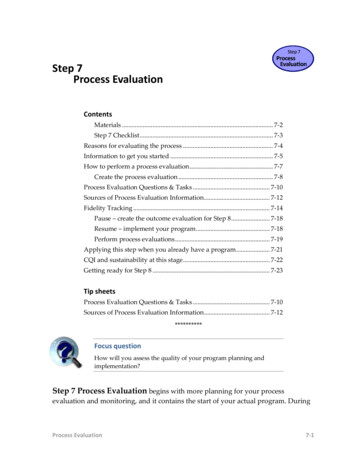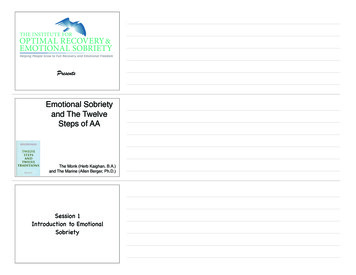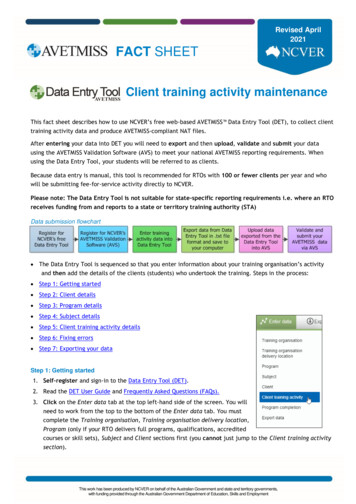
Transcription
Step 7Process EvaluationContentsMaterials . 7-2Step 7 Checklist . 7-3Reasons for evaluating the process . 7-4Information to get you started . 7-5How to perform a process evaluation . 7-7Create the process evaluation . 7-8Process Evaluation Questions & Tasks . 7-10Sources of Process Evaluation Information. 7-12Fidelity Tracking . 7-14Pause – create the outcome evaluation for Step 8 . 7-18Resume – implement your program . 7-18Perform process evaluations . 7-19Applying this step when you already have a program . 7-21CQI and sustainability at this stage . 7-22Getting ready for Step 8 . 7-23Tip sheetsProcess Evaluation Questions & Tasks . 7-10Sources of Process Evaluation Information. 7-12**********Focus questionHow will you assess the quality of your program planning andimplementation?Step 7 Process Evaluation begins with more planning for your processevaluation and monitoring, and it contains the start of your actual program. DuringProcess Evaluation7-1
Step 6, you methodically selected an evidence-based teen pregnancy preventionprogram (EBP), and developed plans for rolling it out. Congratulations!Now, in Step 7 before you implement your program, you’ll decide how to monitorand document the quality of your program implementation. Between deciding whatto measure and initiating the process and outcome evaluations—still prior toimplementation—you’ll also want to develop measures for the Step 8 OutcomeEvaluation. When the program is completely finished, you’ll return to Step 8 andfinish the outcome evaluation itself. Steps 7 and 8, therefore, encompass two periodsof time each—a creation phase and an evaluation phase—the first phase being theperiod for which you’ll want to consider and plan prior to implementing. Once youactually start the program, you’ll initiate the process and outcome evaluationsactivities.Key pointPlanning the process evaluation reveals what you need to measureand how to measure it during program implementation.MaterialsFor the planning portion of this step, you’ll need:7-2 Completed Step 2 BDI Logic Model tool Completed Step 6 work plan and associated tool Copies of the Step 7 Process Evaluation Planner tool Curriculum materials for the selected program, including descriptions ofspecific components Extra copies of the tip sheets Process Evaluation Questions & Tasks (p. 7-10) andSources of Process Evaluation Information (p. 7-12) Copies as desired of the Sample Project Insight Form, Sample End ofSession Satisfaction Survey, Sample Overall Satisfaction Survey, andSample Fidelity Rating Instrument For the evaluation portion of this step,you’ll need: Your assessment instruments Copies of the Step 7 Process Evaluation toolProcess Evaluation
Step 7 ChecklistPrior to launching your program Develop a clear process evaluationWhen the process and (Step 8) outcome evaluations are set Implement your teen-pregnancy prevention programOnce your program has begun Examine whether the activities captured in your logic model wereimplemented as planned. Monitor the work plan you started in Step 6. Determine the quality of your activities. Identify and make midcourse corrections as needed Track the number of participants and their attendance Monitor your program fidelityFayetteville Youth Network tackles Step 7As FYN prepared to launch Making Proud Choices! for the first time, the workgroup paused before completing its work plan to familiarize themselves withtasks and tools needed to conduct a high quality process evaluation. Using theProcess Evaluation Planner, the work group made decisions about the methodsand tools they would use, paying particular attention to any pre-test informationthey needed to capture before launching MPC.The work group also noted that, as part of ongoing staff and peer facilitatortraining during implementation, they wanted to make sure that people could tellwhen it was appropriate to make midcourse corrections and identify the meansto handle them.Process Evaluation7-3
Reasons for evaluating the processMeasuring the quality of your implementation efforts tells you how well yourwork plan and the program process are proceeding. Using a variety of methodsto assess the ongoing implementation process, you can recognize immediate andcritical opportunities for making midcourse corrections that will improveprogram operation.Objective measures also provide data you need to maintain accountability withyour stakeholders, organization, and funding sources. Many granting agenciesrequire as a condition for approval that proposals promise standard evaluationmeasures accompanied by an unbroken paper trail.As we discussed in Step 3 Best Practices, implementing an EBP with quality andfidelity increases your chances of replicating its success. Therefore, this step alsoshows you ways to track and measure quality and fidelity.CollaborationA formal process evaluation provides transparency for partners andstakeholders.7-4Process Evaluation
Information to get you startedA process evaluation helps you identify successful aspects of your plan that areworth repeating and unsuccessful aspects that need to be changed. With yourwork plan and the curriculum, you will identify measurable items such asdosage, attendance, session quantity, and content covered. The data will helpyou improve your program in the short and long terms.Short-term benefitProcess evaluations produce in-the-moment data indicating, first, whether youimplemented everything you had planned, and then second, how well things aregoing, thus providing opportunities to eliminate problems and adjust youractivities as needed in real time. As your program proceeds, you want to monitorthose factors you can control—like the time activities start and end—and thoseyou can’t—like a snowstorm that forces participants to stay home. If theappointed hour turns out to be inconvenient or you need to repeat a session,timely data suggest the need to reschedule.If you can, you also want to use opportunities for improvement as they arise,rather than wait and miss your chance as problems grow or resources diminish.For example, if monitoring indicates that you’re in danger of running out ofmoney when the program is 75% complete, you may still be able to raise more oreconomize. Finally, monitoring can indicate corrections to make before theprogram is implemented again, such as updating a video.Long-term benefitWhen you developed your BDI Logic Model, you saw the close tie between theintervention activities and your desired outcomes. Evaluating yourimplementation process, therefore, can help explain why you did or did notreach your desired outcomes.Combining good data from the Step 7 Process Evaluation and the Step 8Outcome Evaluation will help you reach productive conclusions about thesuitability of your program and the quality with which you implemented it. Bothtypes of information are essential to any organization committed to a long-termcommunity presence, dedicated to making a difference in the prioritypopulation, and accountable to outside funding sources, collaborators, andstakeholders.Process Evaluation7-5
If the process evaluation showed And the outcomeevaluation showed High-quality implementationPositive outcomesHigh-quality implementationNegative outcomesPoor-quality implementationNegative outcomesThen it’s likely the staff choseand developed an Appropriate program andlogic modelInappropriate program andlogic modelAppropriate OR inappropriateprogram or logic modelKey pointIt’s just as important to identify any successes you want to repeat as itis to change what’s not working well.7-6Process Evaluation
How to perform a process evaluationThe process evaluation tells you how well your plans are being put into action. Itmeasures the quality and fidelity of your implementation, participantsatisfaction, staff perceptions, and adherence to the work plan by compiling datain six areas: Participant demographics Individual participant attendance Fidelity to the selected program Participant satisfaction Staff perceptions Adherence to the work plan Clarity and appropriateness of communicationWe’ve created tip sheets to help you select evaluation methods that will work foryou in each of these six areas. We’ve also provided a tool on which you cancompile your decisions about gathering the data. Upon implementing theprogram you will use your selected instruments to gather the actual data.Finally, you can compile the information on the Process Evaluation tool. Thissection, therefore, is divided into two parts, each with its own tasks: create theprocess evaluation and perform process evaluations.Memory Flash: Get help/get ready!It’s all about getting your ducks in a row, so have you Hired an evaluator if you need one? Committed to evaluation? Truly recognized your limits? Obtained broad leadership support?You will create the evaluation instruments now and then proceed to Step 8Outcome Evaluation to do the same for outcomes. With both evaluationinstruments in hand, you will implement the program. Once it is up andrunning, you will then return to this step and evaluate the implementation as itprogresses.Process Evaluation7-7
Create the process evaluationIn order to develop a process evaluation that is specific to your selected programand to your health goal and desired outcomes, you will need to proceedmethodically. We suggest the following sequence:1. Engage or assign personnel to perform the evaluations2. Decide what to measure3. Choose methods for obtaining data4. Set the schedule and assign the responsible parties1. Engage or assign personnel to perform the evaluationsPersons evaluating implementation should be independent of facilitators andother persons involved with presenting a program, and vice versa. Separatingimplementation and evaluation personnel helps avoid conflicts of interest, letalone burnout. Though everyone involved in the program is committed to itssuccess, the goals, requirements, and personal stake in presentation andevaluation differ. For the cleanest data you need a separation of duties. Whetheryou hire outside evaluators or train someone associated with your organizationis a matter of budget and opportunity. Whichever path you take, however,evaluators must remain independent of facilitators.2. Decide what to measureWe strongly recommend that, throughout the program, you track informationabout participation, adherence to curriculum and planning, and personalperceptions. The Process Evaluation Questions & Tasks tip sheet (p. 7-14) frames theareas of interest as questions and then suggests methods for obtaining answers.Informed by the curriculum and your BDI Logic Model, use the tip sheet tobrainstorm a list of specific program elements that you need to monitor.ParticipationDemographic data reveals the success of the program at reaching your prioritypopulation. Demographic data is essential to describing the teens that attendsessions in your program. It can include, but isn’t limited to, age, sex, familysize, race/ethnicity, grade/education level, job, household income, andreligion. You’ve probably gathered this sort of information in the course ofplanning, establishing, or running other programs. You can use surveys andinterviews to get it.7-8Process Evaluation
Attendance records reveal participant dosage. Keep records of participantattendance at each session, using a roster of names and sessions by date.Fidelity to curriculum and adherence to the work planFidelity monitoring shows how closely you adhered to the program. As we’vestated, the closer you can come to implementing the program as intended, thebetter your chance of achieving your goals and desired outcomes.Measuring adherence to your work plan assesses its quality and exposesproblematic departures. Use the work plan you created in Step 6 to identifymeasurable benchmarks.Personal perceptionsParticipant satisfaction leads to commitment. Evidence-based programsdepend on certain minimum dosages for validity, which makes returningparticipants a prerequisite to success. As each session ends or at theconclusion of the program, you can conduct satisfaction surveys or debriefwith participants.High program satisfaction doesn’t inevitably produce desired outcomes,however. A program could have very satisfied participants who do notimprove at all in the areas targeted by the program. Satisfaction surveysshould be considered one part of an overall evaluation.Staff perceptions provide a mature view of an event. Sometimes the presenteris the only staff member present, but most sessions call for other adults tolend a hand. Obtaining staff perceptions can be as simple as holding a quickdebriefing after a session and as thorough as a scheduled focus group.Periodically having an observer witness sessions can also give outsideperceptions of the program’s implementation.Tip sheet aheadProcess Evaluation Questions & Tasks offers questions and the meansto gather the answers.Process Evaluation7-9
Process Evaluation Questions & TasksProcess EvaluationQuestionsWhat are the programparticipants’characteristics?2. What were the individualprogram participants’dosages?3. What level of fidelity didthe program achieve?1.4.What is the participants’level of satisfaction?When AskedEvaluationMethods & ToolsBefore and afterprogramimplementationDuring program;summarize afterData collection form,interview, orobservationAttendance e:lowmoderateDuring/afterprogramFidelity monitoring/staffFidelity monitoring/observersSatisfaction fterprogramFocus groups5.What is the staff’sperception of theprogram?During/afterprogramDebriefingStaff surveysFocus groupsInterviewsHow closely did theprogram follow the workplan?7. How clearly did the staffcommunicate programgoals and ramDuring/afterprogramComparison ofactual to plannedeventsObserversSurveys and focusgroups
3. Choose methods for obtaining dataSelect data-gathering methods and instruments that will supply the informationyou’ve identified for revealing the quality of your implementation processes. Asyou select methods, keep in mind your organization’s current resources andcapacities. Ideally, you will want to assign at least one method to each questionshown in the tip sheet on Process Evaluation Questions & Tasks.Data collection forms and surveysCollect demographic data from individual participants with fill-in-the-blankquestionnaires (perhaps included in your pre-test survey, which we cover inStep 8) or structured program enrollment forms/documents. You can chooseto collect this information anonymously in order to obtain details therespondent may otherwise find too intimate for sharing. Consider thiscarefully, however, as it will limit your ability to link these data to otheraspects of your program.Rosters and attendance sheetsAttendance records track participant attendance at each session, which willallow you to quantify program dosage per participant (e.g., Bob received 50%of the program, Sally received 80% of the program).Satisfaction surveysObtain immediate, detailed feedback (1) at the end of each session and/or (2)at the end of the entire program by handing out anonymous surveys. Oncethe program ends, surveys can help you sum up pros and cons regarding thegroup’s efforts. Satisfaction surveys are best used in combination with othermethods because participants often limit ratings to “somewhat satisfied.”Strong negative results require serious attention, but, as we mentionedearlier, high satisfaction does not necessarily equate with positive outcomes.You can find examples of satisfaction surveys on the CDC Teen Pregnancywebsite that came with this guide: Sample End of Session Satisfaction Surveyand Sample Overall Satisfaction Survey.Tip sheets aheadThe Sources of Process Evaluation Information, p. 7-12, summarizessome common ways to get information.Fidelity Tracking, p. 7-14, expands on the primary means of assessingadherence to the program.7-11
Sources of Process Evaluation InformationData Collection FormWhat it is: A handout for gathering information from individuals OR a roster the facilitator uses todocument participationHow to use it: To make sure that you get complete and valid data, be strategic about information yougather, keep the form as short and easy to finish as possible, and consider making it anonymous if you aregathering details that participants may be reluctant to share.Advantage: You can obtain a variety of data for statistical analysis.Satisfaction SurveyWhat it is: Information collected from participants after an event. It reveals the level of enjoyment,perceived value, perceived clarity of the information as delivered, and degree to which the event met needsor expectations. Best used in combination with other measures for the whole picture.How to use it: For immediate, detailed feedback, administer brief surveys to participants at the end of eachsession or activity. In addition at the end of a program, you can hand out surveys with self-addressed,stamped envelopes for participant to complete and return later (see the CDC Teen Pregnancy website for aSample End of Session Satisfaction Survey and a Sample Overall Satisfaction Survey). This latter approachwill increase participants’ sense of privacy, but will result in a lower response rate.Advantage: Immediate understanding of issues that may impact participant enjoyment, likelihood ofreturning, and areas to fine tune.DebriefingWhat it is: Quick post-session meeting to gather observer insight into what worked and what didn’t.How to use it: Right after a session, gather staff members, volunteers, and others from whom you desirefirst-hand observations. Ask them to quickly complete a project insight form (see the CDC Teen Pregnancywebsite for a Sample Project Insight Form) or note their responses to two quick questions: What went well in the session? What didn’t go so well, and how can we improve it next time?Advantage: Staff members and other adults can offer observations on the implementation quality.Focus GroupWhat it is: A trained facilitator-led discussion of a specific topic by a group of 8-10 persons.How to use it: Typically focus groups are led by 1-2 facilitators who ask the group a limited number of openended questions. Facilitators introduce a broad question and then guide the group to respond withincreasing specificity, striving to elicit opinions from all group members. Record the proceedings anddesignate note takers. Analyze the data by looking for emerging themes, new information, and generalopinions.Advantage: They give you an opportunity to gather a broader range of information about how people viewyour program and suggestions to make your program better.7-12
Fidelity TrackingWhat it is: The systematic tracking of program adherence to the curriculum.How to use it: An evidence-based program should contain a fidelity-monitoring instrument. If it doesn’t,contact the distributers to see if they have one. If a fidelity instrument isn’t available or you developed yourown program, use the Fidelity Tracking tip sheet to create and employ your own.Advantage: The closer you come to implementing the program as it was intended, the better your chancesof achieving your goals and desired outcomes.Sources: Getting to Outcomes: Promoting Accountability Through Methods and Tools for Planning,Implementation and Evaluation, RAND Corporation (2004); Getting to Outcomes With Developmental Assets:Ten Steps to Measuring Success in Youth Programs and Communities , Search Institute (2006)7-13
Fidelity TrackingSimple tracking/rating forms are easy ways to track fidelity. If you’re using an EBPkit or package, check to see if it includes a fidelity instrument. If it doesn’t, contactthe distributors to see if they have one. They are not always included with packagedprogram materials, but you can develop your own from the curriculum materials.Find the lists of session objectives and major activities in the material—the moredetail the better—to get started.1. List the sessions and the key activities associated with them2. To each activity, add one or more statements of accomplishment,according to curriculum expectations. Check out the Sample Fidelity RatingInstrument on the CDC Teen Pregnancy website.3. Add a rating column to the left of the list.Did not coverCovered partiallyCovered fully1234. Calculate the average score: sum the checklist items and divide the totalby the number of items. Repeat for each session; then average the sessionsfor an overall fidelity score.5. Calculate the average percent of activities that are covered fully: Count thenumber that are covered fully and divide by the total number of activities.Repeat for each session, then average the percentage for all sessions.There is no golden rule but higher levels of fidelity (above 80%) areconsidered good.Who does the rating? You decide. There are pros and cons for each type of rater.Below, we offer a summary of pros and cons to aid in your decision-making.Program presentersProsInexpensive because they’re already presentShould know the material enough to rate what ishappeningChecklists help them plan sessionsConsCould produce biased ratingsMay resent the extra work involved in making theratingsProgram participantsProsInexpensive because they’re already presentAble to rate the “feel” of the program (e.g., Did thesession allow for participant discussion?)ConsDo not know the program well enough to rate whatshould be happening (regarding content)Could take time away from activitiesOutside raters (by live observation or viewing videotapes)ProsLikely to provide the least biased ratings7-14ConsRequires resources: training in rating, extra staff,and possibly videotape equipment
ToolThe Process Evaluation Planner displays the seven questions fromthe tip sheet and provides columns for entering your decisions aboutaddressing them.Session debriefingsImmediately following a session, midway through the program, or at the endof the program, you can hold a quick debriefing meeting to get instant, firsthand feedback from observers (not participants) such as staff members,facilitators, or volunteers. You can gather the information by asking them tocomplete an insight form (see Sample Project Insight Form on the CDC TeenPregnancy website). More commonly, debriefing boils down to taking notesduring a quick conversation about three questions:What went well in the session(s)?What didn’t go so well?How can we improve it next time?Focus groupsElicit valuable—even surprising—information from participants, staff,volunteers, partners, parents, and other members of the community byholding a formal focus group. The usual focus group employs one or twotrained facilitators leading a group discussion on a single topic. Groupsusually contain no more than 8-10 people brought together for a couple ofhours to share their opinions. The format is designed to draw out ideas thatmembers may not have articulated to themselves, yet, or that they arereluctant to share. Usually, the event is structured like a funnel—with eachmajor topic starting with broad questions and narrowing for increasingspecificity. It’s up to the facilitator to moderate group dynamics as theyemerge, make sure that everyone gets their say, and tease out thorny orcontroversial issues.It can be useful to audiotape the focus group and to designate note takers.Analyzing audiotapes takes time, however. Analysis involves looking forpatterns or themes, identifying attitudes, and noting word choices. The resultis qualitative (as opposed to quantitative) insight into the way groupmembers are thinking. Listening as people share and compare their differentpoints of view provides a wealth of information about the way they think and7-15
the reasons they think the way they do. For youth focus groups, see the ETRdeveloped focus group guide on the CDC website.OnlineFocus Group Best practices developed by ETR Associates describes allaspects of conducting focus groups from development to analysis:http://pub.etr.org/upfiles/etr best practices focus groups.pdfFocus Groups: A Practical Guide for Applied Research by RichardKrueger and Mary Anne Casey is a straightforward how-to guide(2009) available from SAGE Publications: www.sagepub.comYour process evaluation instruments will probably include a combination ofsurveys, assent or consent forms, attendance sheets, and meeting notes. Pleasethink carefully about the means you will use to collect and store the data.4. Set the schedule and assign the responsible partiesOnce you have selected your methods you should set the schedule foradministering them and assign the appropriate person to do so. You will haveassociated at least one method with each of the seven questions. You also need tomake sure that your choices result, at the very least, in a method for each session.NoteIf you’ve set the program schedule, you might find it helpful to addthe process evaluation schedule to it and list the associated methods.Regarding the keeper of the data, this assignment is as important as any youmake in the course of setting up and providing a program. You need to select anorganized person on whom you can rely to be consistent and thorough. Poorlyadministered collection or lost data could invalidate your evaluation and keepyou in the dark as to how well your efforts are being implemented. Enter theschedule and assignment on the Process Evaluation Planner.Save itSave the Process Evaluation Planner and any instruments you planto use. You’ll need them once the program gets started.7-16
FYN completes the Process Evaluation PlannerProcess Evaluation PlannerEvaluation Methods & ToolsAnticipated Schedulefor CompletionPerson ResponsibleDemographic datacollection (surveys orobservations)First sessionSessionFacilitatorWhat were theindividualdosages of theprogramparticipants?3. What level offidelity did theprogramachieve?Create attendanceroster and take roll atevery meetingEach sessionPeer facilitatorFidelity tracking toolcompleted by facilitatorEach sessionProgramdirector4.How satisfiedwere theparticipants?Brief surveysalternating with quickdebriefs at each sessionOne or the other ateach session on analternating scheduleon the class calendarPeer facilitatoror adultvolunteer5.What was thestaff’sperception ofthe process?Debriefing after sessionsand a focus groupmidwayEach session and anOctober 3rd focusgroup in theauditoriumWeekly debrief byfacilitator andthe focus grouprun by a trainerInclude a comparisonin the weekly debriefWeeklyFacilitator andclassroomvolunteersPart of debrief andfocus group sessionsweeklyFacilitator andvolunteers1.What were theprogramparticipantcharacteristics?2.How closely didthe programfollow the workplan?7. How clearly didthe staffcommunicateprogram goalsand content?6.7-17
Pause – create the outcome evaluation for Step 8This is a good time to read ahead through Step 8 Outcome Evaluation and createthe instruments you’ll need for evaluating the impact of your program. Youmight discover that you need a pre-test survey of participant determinants andknowledge. Or, for more sophisticated evaluation, you might want to recruit acontrol group. Working on the Step 8 instruments now certainly will give you ahandle on timing for both process and outcome evaluations. When you haveidentified the tools you need for both steps and set the schedule for employingthem, you’ll be ready to implement your program and start evaluating it.If you do decide to gather information from pre- and post-tests, you will need toschedule your pre-tests with participants before the program launches. Thiscould be done in advance of your first session or it could be done right at thebeginning of your first session, before facilitators start delivering programcontent. You will want to have a way of gathering and tracking the pre-tests sothat you can later match them to individual post-tests.Resume – implement your programNow that you have the tools you need for performing the evaluations called forin both Steps 7 and 8, you’re ready to implement your program. This means youwill initiate two threads simultaneously: Program implementation activities have begun, and any pre-testing hasbeen performed or control group instituted. Process evaluation data is being gathered.ToolAfter each session, compile data on a copy of the ProcessEvaluation. At the end of the program, aggregate the data on a singlecopy of the tool.7-18
Perform process evaluationsNow that you’ve started implementing your program, it’s time to start followingyour process evaluation schedule and accumulating the data. Here’s where theimportance of the keeper of the data intensifies: conclusions about th
Copies of the Step 7 Process Evaluation Planner tool Curriculum materials for the selected program, including descriptions of specific components Extra copies of the tip sheets Process Evaluation Questions & Tasks (p. 7-10) and Sources of Process Evaluation Information (p. 7-12) Copies as desired of the Sample Project Insight Form, Sample End of










